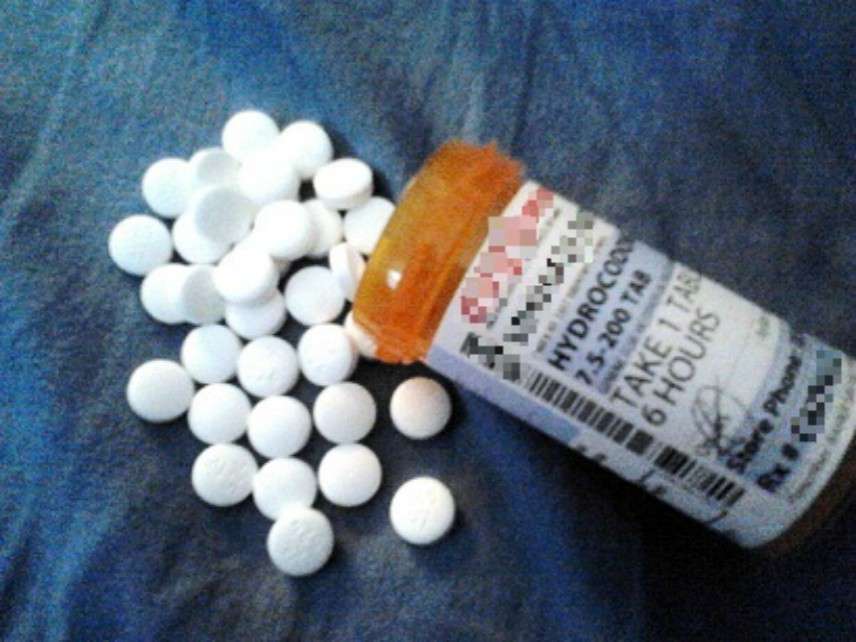The New York Times Suggests Opioids Should Be Reserved for Terminal Patients
An editorial calling for further restrictions on pain pills grossly exaggerates their dangers.

The New York Times agrees that "people with cancer and other terminal conditions who experience excruciating pain" should have access to opioid analgesics, albeit as "a last resort." But the paper's editorial board seems to think that other patients—people with gunshot wounds or broken bones, people recovering from surgery, people who are not on the verge of death but have chronic conditions that cause severe pain—should take Attorney General Jeff Sessions' advice to "take some aspirin" and "tough it out."
According to the Times, opioids "pose a great risk when used to treat the kinds of pain for which there are numerous nonaddictive therapies available." Apparently it does not matter whether those "nonaddictive therapies" are equally effective, as long as they are "available." This cruel prescription is based on an analysis of the "opioid crisis" that ignores important distinctions and grossly exaggerates the dangers to people who use narcotics for pain relief.
The Times is wrong when it asserts that opioids prescribed for pain "pose a great risk" to patients. The research indicates that the risk of addiction in people who take opioids for acute pain is quite low, something like 1 percent. Addiction rates are higher but still modest, according to most studies, among people who take opioids for chronic pain. The risk of a fatal overdose among patients with opioid prescriptions is even smaller—on the order of 0.02 percent a year, judging from a 2015 study of opioid-related deaths in North Carolina.
The Times conflates deaths involving all opioids with deaths involving pain pills. It says "opioid overdoses killed more than 45,000 people in the 12 months that ended in September," citing a provisional count by the U.S. Centers for Disease Control and Prevention. In the context of an editorial about the dangers of opioid analgesics, the implication is that those deaths were caused by careless prescribing. Yet a large majority of them involved heroin and illicitly produced fentanyl.
The Times says "about 2.6 million people suffer from opioid use disorder" in the United States, citing an unspecified "government survey." The 2016 National Survey on Drug Use and Health put that number at 2.1 million, 1.8 million of whom were using prescription pain relievers. The Times does not mention the total number of Americans who use prescription pain relievers, which according to NSDUH was 92 million in 2016.
In other words, NSDUH found that 2 percent of the people who used prescription opioids, whether legally or illegally, experienced a substance use disorder (SUD). By comparison, the same survey indicates that 9 percent of drinkers experienced an alcohol use disorder in 2016. Maybe whiskey should be reserved for dying cancer patients.
The Times erroneously equates SUD with addiction, a narrower category. SUD subsumes what used to be known as "substance abuse" and the more severe "substance dependence," which corresponds with what most people have in mind when they talk about addiction. Someone who is not addicted can qualify for a diagnosis of opioid use disorder by meeting two out of 11 criteria, which include a "strong desire" for opioids, using more of them than intended, and using them in physically hazardous situations.
The Times describes people with opioid use disorder as "pain patients who are addicted to their prescription pills." The implication is that medical treatment is the usual route to opioid addiction. But according to NSDUH, just 37 percent of people who used pain pills for nonmedical purposes in 2016 obtained them through prescriptions written for them, and that does not necessarily mean they began as bona fide patients. Opioid-related deaths usually involve polydrug users with histories of substance abuse and psychological problems, as opposed to drug-naive patients who accidentally get hooked while being treated for pain.
Because the Times overestimates the risks that opioids pose for the average pain patient, it ends up endorsing restrictions that are bound to cause needless suffering. "To stem the number of new opioid users," it says, "lawmakers and regulators need to stop pharmaceutical companies from marketing drugs like OxyContin and establish stronger guidelines about how and when doctors can prescribe them."
Attempts to prevent addiction by reducing access to prescription analgesics already have made it difficult or impossible for many people who suffer from severe chronic pain to obtain the medication they need to make life bearable. As the Times itself noted last week, the crackdown on pain pills has raised "questions about whether some pain patients are now being undertreated, and whether tightened prescribing over the last few years has contributed to the surge in overdose deaths from heroin and especially fentanyl."
Although opioid prescriptions have fallen substantially since 2011, opioid-related deaths continue to rise. That is mainly because of dramatic increases in deaths related to heroin and illicit fentanyl, which are more dangerous than legally produced opioids because their potency is unpredictable. To the extent that restrictions on prescription pain relievers are driving nonmedical users into the black market, they are contributing to those trends. But even deaths involving pain pills have risen since 2011.
The problem, according to the Times, is that this seemingly counterproductive strategy has not been pursued aggressively enough. "Doctors have been writing fewer opioid prescriptions in recent years," it says, "but even the new level is too high." How does the Times (or the Drug Enforcement Administration) know what level of opioid prescriptions is just right? It doesn't, and therein lies the problem for patients who suffer from severe pain but are not lucky enough to be dying from cancer.


Show Comments (87)